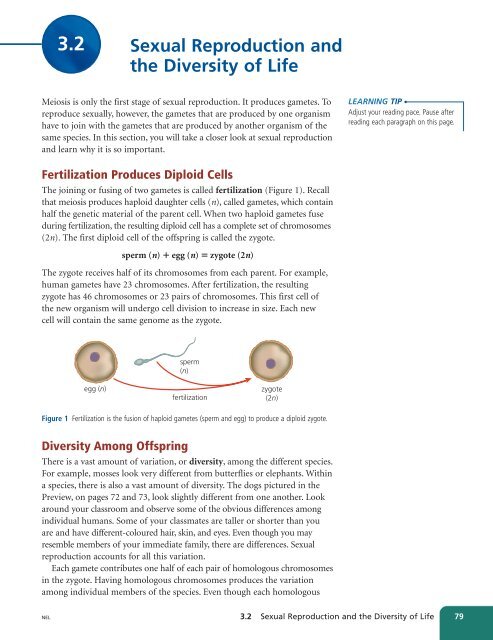Unit A Reproduction
Unit A Reproduction
Unit A Reproduction
Create successful ePaper yourself
Turn your PDF publications into a flip-book with our unique Google optimized e-Paper software.
3.2 Sexual <strong>Reproduction</strong> and<br />
the Diversity of Life<br />
Meiosis is only the first stage of sexual reproduction. It produces gametes. To<br />
reproduce sexually, however, the gametes that are produced by one organism<br />
have to join with the gametes that are produced by another organism of the<br />
same species. In this section, you will take a closer look at sexual reproduction<br />
and learn why it is so important.<br />
LEARNING TIP<br />
Adjust your reading pace. Pause after<br />
reading each paragraph on this page.<br />
Fertilization Produces Diploid Cells<br />
The joining or fusing of two gametes is called fertilization (Figure 1). Recall<br />
that meiosis produces haploid daughter cells (n), called gametes, which contain<br />
half the genetic material of the parent cell. When two haploid gametes fuse<br />
during fertilization, the resulting diploid cell has a complete set of chromosomes<br />
(2n). The first diploid cell of the offspring is called the zygote.<br />
sperm (n) egg (n) zygote (2n)<br />
The zygote receives half of its chromosomes from each parent. For example,<br />
human gametes have 23 chromosomes. After fertilization, the resulting<br />
zygote has 46 chromosomes or 23 pairs of chromosomes. This first cell of<br />
the new organism will undergo cell division to increase in size. Each new<br />
cell will contain the same genome as the zygote.<br />
sperm<br />
(n)<br />
egg (n)<br />
fertilization<br />
zygote<br />
(2n)<br />
Figure 1 Fertilization is the fusion of haploid gametes (sperm and egg) to produce a diploid zygote.<br />
Diversity Among Offspring<br />
There is a vast amount of variation, or diversity, among the different species.<br />
For example, mosses look very different from butterflies or elephants. Within<br />
a species, there is also a vast amount of diversity. The dogs pictured in the<br />
Preview, on pages 72 and 73, look slightly different from one another. Look<br />
around your classroom and observe some of the obvious differences among<br />
individual humans. Some of your classmates are taller or shorter than you<br />
are and have different-coloured hair, skin, and eyes. Even though you may<br />
resemble members of your immediate family, there are differences. Sexual<br />
reproduction accounts for all this variation.<br />
Each gamete contributes one half of each pair of homologous chromosomes<br />
in the zygote. Having homologous chromosomes produces the variation<br />
among individual members of the species. Even though each homologous<br />
NEL<br />
3.2 Sexual <strong>Reproduction</strong> and the Diversity of Life 79

















